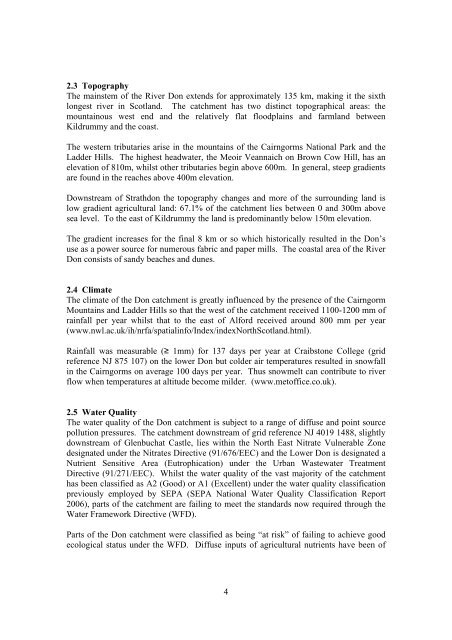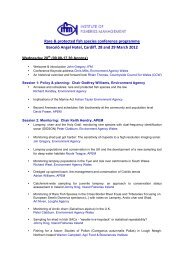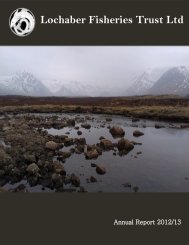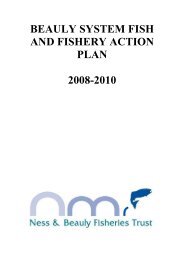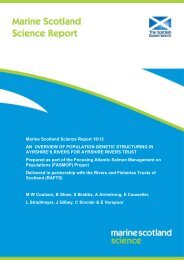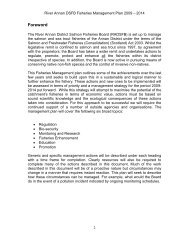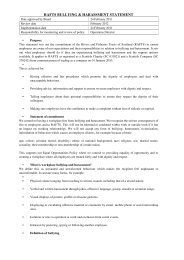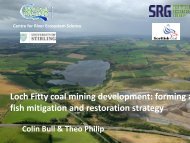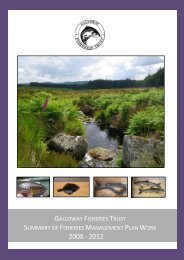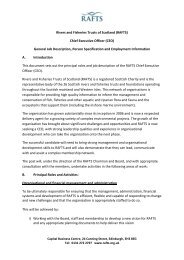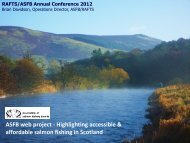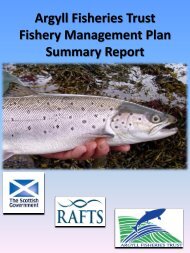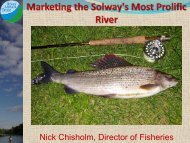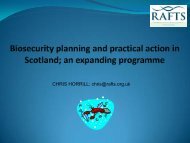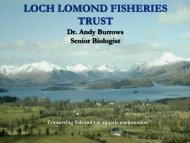Create successful ePaper yourself
Turn your PDF publications into a flip-book with our unique Google optimized e-Paper software.
2.3 TopographyThe mainstem of the River <strong>Don</strong> extends for approximately 135 km, making it the sixthlongest river in Scotland. The catchment has two distinct topographical areas: themountainous west end and the relatively flat floodplains and farmland betweenKildrummy and the coast.The western tributaries arise in the mountains of the Cairngorms National Park and theLadder Hills. The highest headwater, the Meoir Veannaich on Brown Cow Hill, has anelevation of 810m, whilst other tributaries begin above 600m. In general, steep gradientsare found in the reaches above 400m elevation.Downstream of Strathdon the topography changes and more of the surrounding land islow gradient agricultural land: 67.1% of the catchment lies between 0 and 300m abovesea level. To the east of Kildrummy the land is predominantly below 150m elevation.The gradient increases for the final 8 km or so which historically resulted in the <strong>Don</strong>’suse as a power source for numerous fabric and paper mills. The coastal area of the River<strong>Don</strong> consists of sandy beaches and dunes.2.4 ClimateThe climate of the <strong>Don</strong> catchment is greatly influenced by the presence of the CairngormMountains and Ladder Hills so that the west of the catchment received 1100-1200 mm ofrainfall per year whilst that to the east of Alford received around 800 mm per year(www.nwl.ac.uk/ih/nrfa/spatialinfo/Index/indexNorthScotland.html).Rainfall was measurable (≥ 1mm) for 137 days per year at Craibstone College (gridreference NJ 875 107) on the lower <strong>Don</strong> but colder air temperatures resulted in snowfallin the Cairngorms on average 100 days per year. Thus snowmelt can contribute to riverflow when temperatures at altitude become milder. (www.metoffice.co.uk).2.5 Water QualityThe water quality of the <strong>Don</strong> catchment is subject to a range of diffuse and point sourcepollution pressures. The catchment downstream of grid reference NJ 4019 1488, slightlydownstream of Glenbuchat Castle, lies within the North East Nitrate Vulnerable Zonedesignated under the Nitrates Directive (91/676/EEC) and the Lower <strong>Don</strong> is designated aNutrient Sensitive Area (Eutrophication) under the Urban Wastewater TreatmentDirective (91/271/EEC). Whilst the water quality of the vast majority of the catchmenthas been classified as A2 (Good) or A1 (Excellent) under the water quality classificationpreviously employed by SEPA (SEPA National Water Quality Classification Report2006), parts of the catchment are failing to meet the standards now required through theWater Framework Directive (WFD).Parts of the <strong>Don</strong> catchment were classified as being “at risk” of failing to achieve goodecological status under the WFD. Diffuse inputs of agricultural nutrients have been of4


